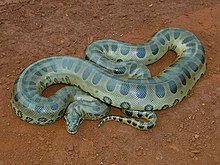
Back Eunectes murinus AN أناكوندا خضراء Arabic اناكوندا خضراء ARZ Anakonda Azerbaijani Анаконда Byelorussian Анаконда BE-X-OLD Зелена анаконда Bulgarian সবুজ অ্যানাকোন্ডা Bengali/Bangla Anaconda verda Catalan Eunectes murinus CEB
This is currently being merged. After a discussion, consensus to merge this with content from Northern green anaconda was found. You can help implement the merge by following the instructions at Help:Merging and the resolution on the discussion. Process started in August 2024. |
| Green anaconda Temporal range: Late Pleistocene-recent[1]
| |
|---|---|

| |
| Scientific classification | |
| Domain: | Eukaryota |
| Kingdom: | Animalia |
| Phylum: | Chordata |
| Class: | Reptilia |
| Order: | Squamata |
| Suborder: | Serpentes |
| Family: | Boidae |
| Genus: | Eunectes |
| Species: | E. murinus
|
| Binomial name | |
| Eunectes murinus | |

| |
| Distribution of Eunectes murinus | |
| Synonyms [4] | |
| |
The green anaconda (Eunectes murinus), also known as the giant anaconda, emerald anaconda, common anaconda, common water boa, or southern green anaconda, is a semi-aquatic boa species found in South America and the Caribbean island of Trinidad. It is the largest, heaviest, and second longest snake in the world, after the reticulated python. No subspecies are currently recognized. Like all boas, it is a non-venomous constrictor. The term "anaconda" often refers to this species, though the term could also apply to other members of the genus Eunectes. Fossils of the snake date back to the Late Pleistocene in the Gruta do Urso locality.[1]
- ^ a b Hsiou, Annie; Winck, Gisele; Schubert, Blaine; dos Santos Avilla, Leonardo (1 June 2013). "On the Presence of Eunectos Murinus (Squamata, Serpentes) from the Late Pleistocene of Northern Brazil". Revista Brasileira de paleontologia. 16 (1).
- ^ Calderón, M.; Ortega, A.; Scott, N.; Cacciali, P.; Nogueira, C. de C.; Gagliardi, G.; Catenazzi, A.; Cisneros-Heredia, D. F.; Hoogmoed, M.S.; Schargel, W.; Rivas, G.; Murphy, J. (22 November 2014), "Eunectes murinus", IUCN Red List of Threatened Species, IUCN (International Union for Conservation of Nature), doi:10.2305/iucn.uk.2021-2.rlts.t44580041a44580052.en Accessed 2022-04-08.
- ^ "Appendices | CITES". cites.org. Retrieved 14 January 2022.
- ^ McDiarmid, R. W.; Campbell, J. A.; Toure, T. (1999). Snake Species of the World: A Taxonomic and Geographic Reference. Vol. 1. Washington, District of Columbia: Herpetologists' League. ISBN 1893777014.
